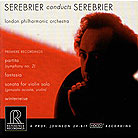July 2000
I have to admit that my interest was piqued when I received this new CD in the mail. While Josť Serebrier may not be a well-known name in the classical-music world, I have been favorably impressed with what I have heard in the past. For the past couple of years I have enjoyed a collection of works by Chadwick on References Recordings [Reference Recordings RR-64CD] performed by Serebrier an d the Czech State Philharmonic. As those of you who have already read one of my recent reviews know, I found Serebrier’s reading with the LPO of Scheherazade nothing short of breathtaking [Reference Recordings RR-89CD]. Since I have a good gauge of Serebrier’s talent as a conductor, I was curious to see what sort of composer he is.I’ll give you fair warning about this album. If you don’t enjoy most modern classical music, then this CD is not for you. Now I have to confess that modern classical music isn’t really my cup of tea either, so I won’t pretend to be an expert where I am not. All of these compositions have a cool objectivity to them that reminds me of Bella Bartok’s highly influential Concerto for Orchestra. Serebrier uses a mixture of melodic and semi-melodic motifs as the basic building-blocks for these pieces. Consequently, these pieces constantly drift in and out of atonality. I found this effect to be quite unsettling. This is not a disc to listen to just before bedtime. A good example of this is the first piece on this album. It is a four-movement composition entitled "Partita." The most gripping of the movements is the funeral march, with crashing crescendos and disturbing string-section parts. If this doesn’t make the hair on the back of your neck stand up, I don’t know what will. As always from a Reference Recordings disc, the sound is demonstration quality. The wide dynamic swings in this music are truthfully rendered, giving them great impact. If you want to impress/terrorize your friends with your audio system, this is the disc for you. This disc definitely grew on me over time. I am happy to see that Reference Recordings is able to mix in some interesting music such as this with the standard repertoire. Definitely a disc worth exploring, if you dare. GO BACK TO: |
 Josť Serebrier - Serebrier
Conducts Serebrier
Josť Serebrier - Serebrier
Conducts Serebrier![[Reviewed on CD]](../format/regcd.gif) For some reason there has always been suspicion cast on a conductor who
performs or records his own compositions. There is a lingering shadow of self-nepotism in
the air surrounding such events. In contrast, nobody blinks an eye when a composer directs
one his own works. All the abuse Leonard Bernstein suffered for conducting his own
compositions is a classic example of this, while when Copland recorded his own works, no
one batted an eye (never mind that Bernstein was better at conducting Copland than Copland
was). It seems that once the labels are applied, certain stigmas and expectations come
with them, for better or worse.
For some reason there has always been suspicion cast on a conductor who
performs or records his own compositions. There is a lingering shadow of self-nepotism in
the air surrounding such events. In contrast, nobody blinks an eye when a composer directs
one his own works. All the abuse Leonard Bernstein suffered for conducting his own
compositions is a classic example of this, while when Copland recorded his own works, no
one batted an eye (never mind that Bernstein was better at conducting Copland than Copland
was). It seems that once the labels are applied, certain stigmas and expectations come
with them, for better or worse.